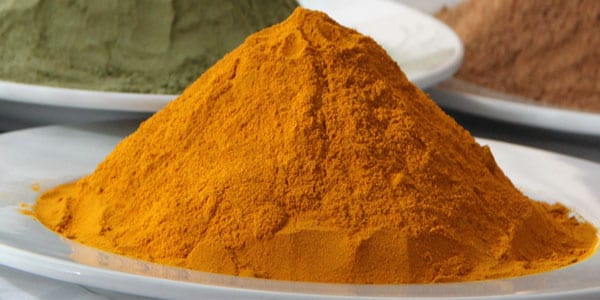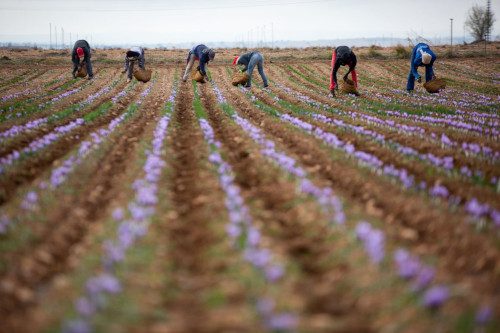
Writes: Tomás Franco author of Manual for Spices
Turmeric corresponds to the rhizomes of the tropical plant Curcuma longa of the Zingiberaceae family. The appearance of turmeric are pieces of yellow roots of great hardness that, once ground, appear as an aromatic powder with an intense yellow color.
The main use of turmeric is the preparation of curry mixes to which it gives its typical color and aroma. In general, it provides an attractive golden color to foods such as soups, sauces, rice, eggs, salads and fish. The industry uses it to color mustard sauces, cheeses, margarines, pickles, and preserves.
But the great medical potential of turmeric lies in its most important component: a yellow pigment called curcumin, which is accompanied by demethoxycurcumin and bis-demethoxycurcumin. Curcumin is responsible for a large number of medical applications
the cúrcuma and health
We are probably facing the spice with the greatest current therapeutic effects and with an enormous potential for future development due to the continuous studies carried out on it.
Turmeric has traditionally been used as a mild digestive and in the treatment of liver conditions as it increases bile secretion. Its cholesterol-lowering effect is also known.
Studies from the University of California at Los Angeles have concluded that curcumin reduces the formation of amyloid plaque in the brain (responsible for Alzheimer's disease) by up to 50%.
The University of Rochester in Great Britain has found that curcumin protects cancer patients undergoing chemotherapy and further enhances the effects of such treatment.
Also research by Jonsson Comprehensive Cancer of the University of UCLA confirms the efficacy of turmeric in cancer treatment. They advise combining curcumin with chemotherapy and radiation therapy, and taking it as a preventive for those at high risk of developing cancer.
Turmeric prevents arthritis and reduces bone destruction, according to studies from the University of Arizona in Tucson (USA).
There are already different medical compositions on the market that incorporate curcumin, but we can also consume curcumin directly from the turmeric itself and the curries that we incorporate into our meals. Another good option is an infusion of green tea with pepper, turmeric and a few drops of lemon juice.
Compositionón nutritional
| Energy (kJ / 100 g) | 1634 |
| Energy (kcal / 100 g) | 387 |
| Carbohydrates (g / 100 g) | 66,7 |
| Sugars (g / 100 g) | 3,2 |
| Total fat (g / 100 g) | 9,6 |
| Saturated fat (g / 100 g) | 3,1 |
| Monounsaturated fat (g / 100 g) | 1,7 |
| Polyunsaturated fat (g / 100 g) | 2,2 |
| Proteins (g / 100 g) | 8,5 |
| MINERALS | |
| Calcium (Ca) (mg / 100 g) | 183 |
| Copper (Cu) (mg / 100 g) | 0,6 |
| Phosphorus (P) (mg / 100 g) | 274 |
| Iron (Fe) (mg / 100 g) | 43 |
| Magnesium (Mg) (mg / 100 g) | 201 |
| Manganese (Mn) (mg / 100 g) | 8 |
| Potassium (K) (mg / 100 g) | 2408 |
| Selenium (Se) (mg / 100 g) | 5 |
| Sodium (Na) (mg / 100 g) | 28 |
| Zinc (Zn) (mg / 100 g) | 5 |
| VITAMINS | |
| Vit. B1 (thiamine) (mg / 100 g) | 0,1 |
| Vit. B2 (riboflavin) (mg / 100 g) | 0,2 |
| Vit. B3 (niacin) (mg / 100g) | 4,1 |
| Vit. B6 (pyridoxine) (mg / 100 g) | 1,0 |
| Vit. B9 (folic acid) (μg / 100 g) | 30 |
| Vit. C (ascorbic acid) (mg / 100 g) | 38 |
| Vit. E (tocopherol) (mg / 100 g) | 3,1 |
| Vit. K (μg / 100 g) | 13 |
And of course we can consume turmeric in countless preparations in the kitchen, such as:
Lamb with cauliflower and cúrcum
Ingredients:
- 2 tablespoons of butter
- 1 cebolla great
- 0,5 kg of lamb
- 2 teaspoons ground coriander
- 2 teaspoons cground urcuma
- 1 teaspoon of ground ginger
- 2 tomates
- 100 gr of yogurt
- 1 small caulifloweryana (500 gr)
- shawl
- ground cayenne
Preparationón:
- Melt the butter in a saucepan.
- Chop the onion and sauté it in the butter.
- AAdd the diced lamb meat.
- AAdd the coriander, the curcuma and ginger.
- Mix well and cook for 10 minutes.
- Thenon toAdd the crushed tomatoes and the yogurt.
- Continue cookingon alreadyAdd the cauliflower in pieces.
- Add salt and a little bit of ground cayenne.
- Mix well alreadyAdd a little water.
- Cover the saucepan and keep over low heat until the cauliflower is cooked.
Further information:
- The World of Spices and Paprika: https://especiasypimenton.blogspot.com.es/
- Spices and Paprika: https://www.facebook.com/especiasypimenton/
- Spice Manual: http://www.amvediciones.com/especias.htm






